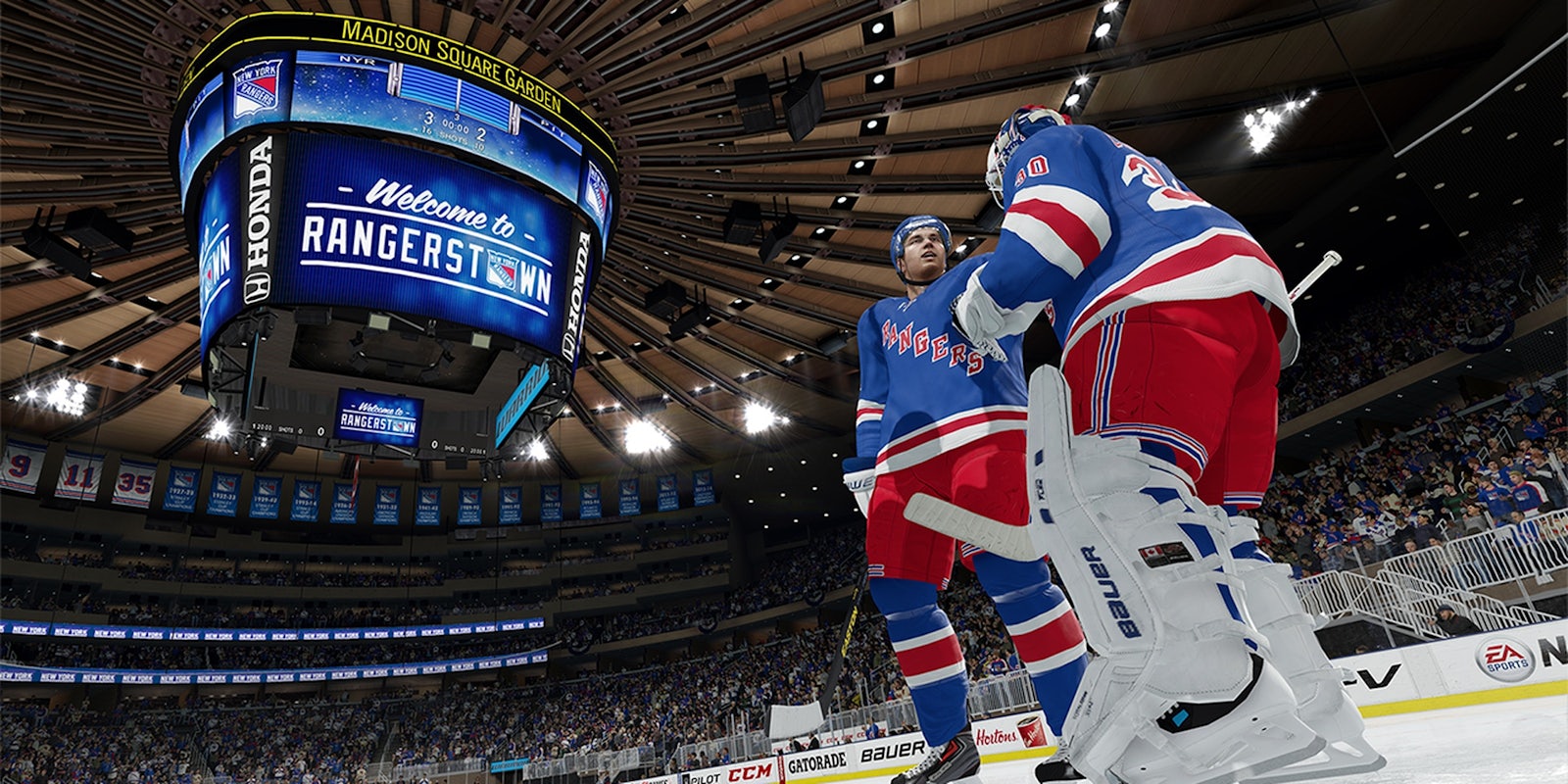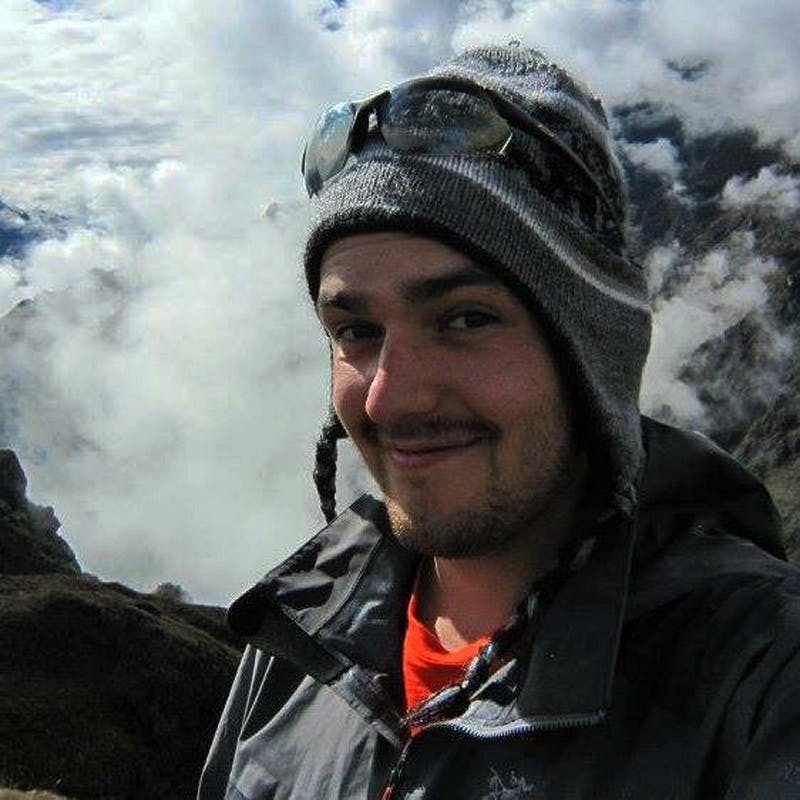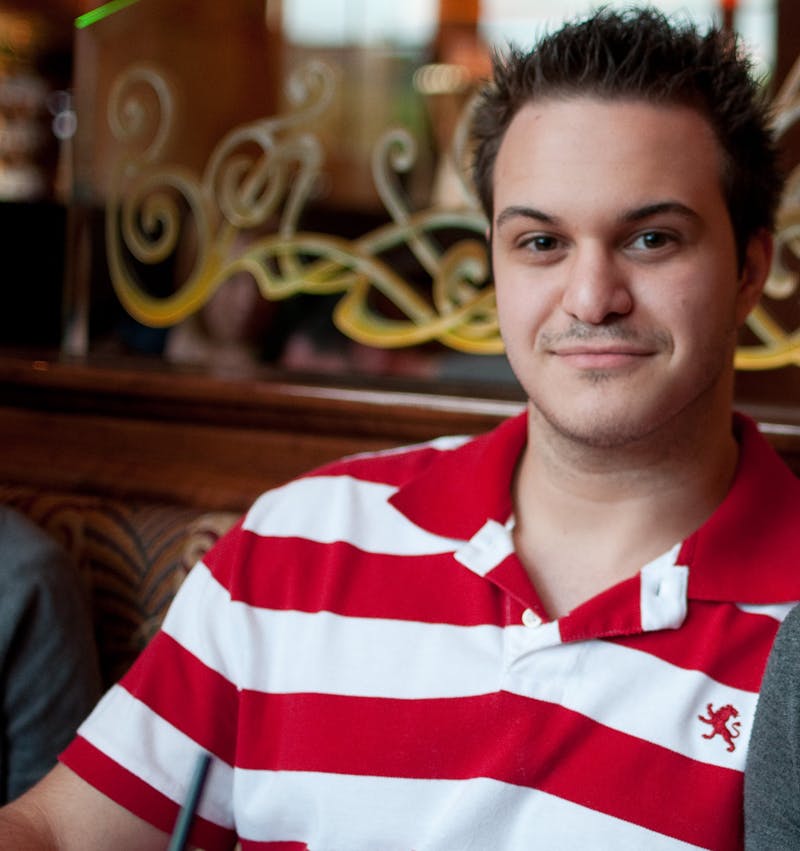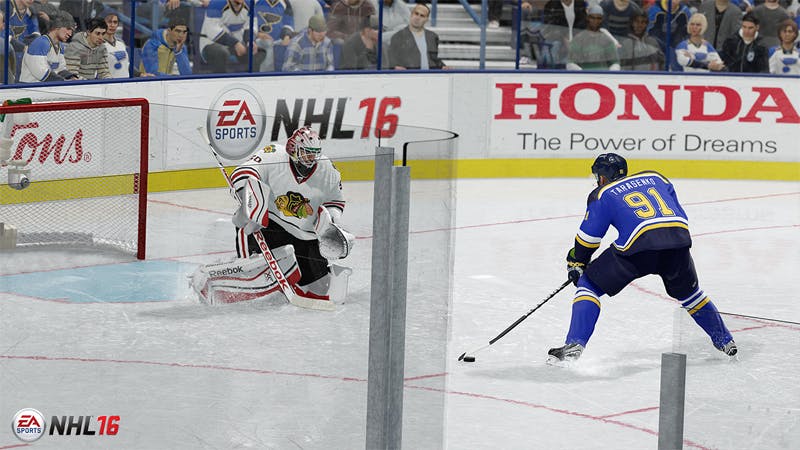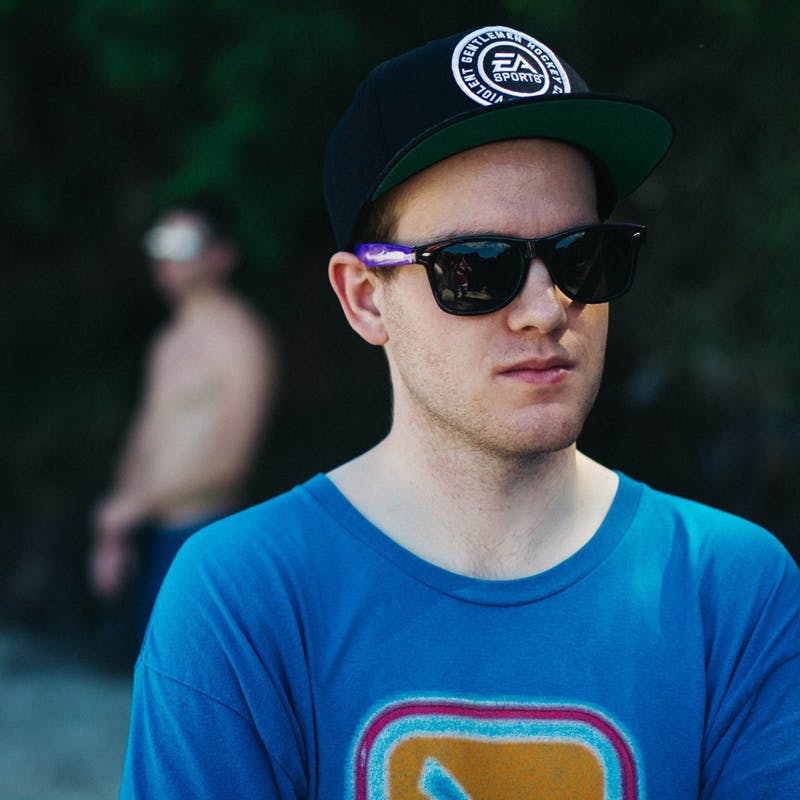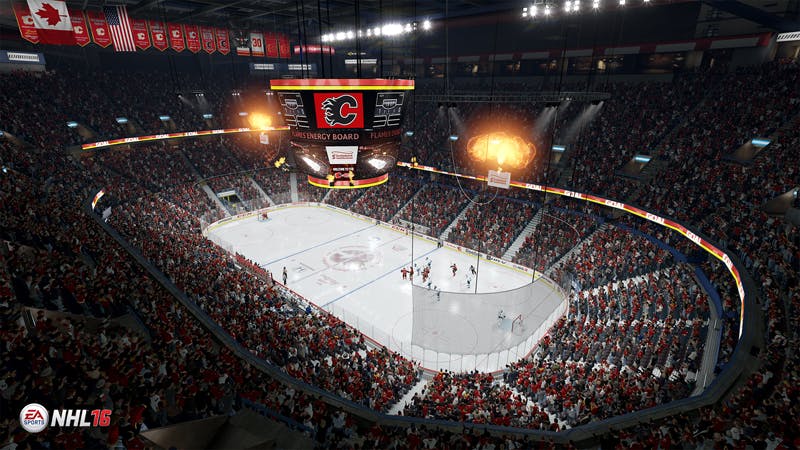What do you do when you manage to piss off a huge portion of your fan base with an arguably unavoidable change to a beloved game franchise?
Something totally unprecedented: You enlist a dozen of the franchise’s most dedicated players to help you make the best version of the game to date.
A NHL video game has been released by Electronic Arts every year since 1991. The games always had a strong following, but it wasn’t until NHL 09 was released in September 2008 that NHL fans were able to form teams to play against each other online. The new mode was called EA Sports Hockey League or EASHL, and it took the game to a whole new level of popularity.
Andy Agostini, an associate producer at EA Vancouver, was in charge of EASHL the year it was released. “Originally, they had asked me a question about how many teams do you think will actually play in the league,” Agostini said. “I thought, ‘Well, if we get about 3,500 teams, that would be pretty good,’ at an average of three to four players per team.”
Agostini’s estimate was completely off. “Within a week we had 40,000 teams created, whether it was two people on a team or full sixes,” he said. “Originally the Clubs could have up to 50 people, and you could rotate games so that it wasn’t just six people could play at a time. We had Clubs running pretty much 24/7, on websites running their franchises, and we were just astonished that it was such a big deal to the community.”
Such a popular feature would be a no-brainer to include in the next edition of the game, right? Well, not exactly.
NHL 15 was the franchise’s first appearance on the PlayStation 4 and Xbox One consoles. It was the most graphically advanced game in the NHL series, and therefore the most highly anticipated. When EA Vancouver announced in a blog post mere weeks before the release of NHL 15 that EASHL would not be included in the PS4 and Xbox One versions—the mode would appear only on the PS3 and Xbox 360 versions—the NHL fan base exploded with anger and disappointment.
Producers took to the NHL forums to explain why EASHL had been left out. The change to the PS4 and Xbox One meant learning how to optimize for new hardware and how to connect all the various pieces of an NHL game up to new software routines. In order to make sure that the modes that did make the cut were of acceptable quality, quite a few modes were left on the chopping block, including EASHL.
The fans were still angry, but appreciated that the producers were engaging in open conversation to explain their reasons for the decision. It was during these forum conversations that EA Vancouver decided, in the spirit of continued openness, to bring in the fans and give them substantive input on the development of NHL 16.
The program, originally called “The EASHL Committee,” collected a dozen NHL players through community nomination and selection by EA from YouTube, Twitch, and the official NHL forums. Several weeks before these 12 players arrived at EA Vancouver for their first visit in February 2015, the name of the program was switched to the Game Changers. And this had more than one of the Game Changers worried.
The name “Game Changers” was borrowed by the developers at EA Vancouver from the developers of the Madden series, who started the Game Changers program as a form of community outreach. Game Changers are given access to beta builds, they share details with fans on the development of the series, and they serve as a conduit for fan input back to the developers. The program, however, doesn’t allow for much substantive collaboration.
Koden Curial, 26, goes to school in Butte, Montana, where he studies petroleum engineering. He was born and raised in Calgary, Alberta, and first got into video game hockey in 1996 playing Wayne Gretzky’s 3D Hockey with his dad on the Nintendo 64.
In 2009 he went to the Art Institute of Vancouver to study game design, and tried to land a job at EA Vancouver to work on the NHL series. “I was offered a QA job, but unfortunately that’s when the [2010 Winter] Olympics hit,” Curial said, “and I could not afford to live there anymore, so I decided to pursue something else, in the meantime.”
Curial kept up with the NHL forums, where he actively shared his feedback on the NHL series. When an application process was opened on the NHL forums to select some of the players who would become the Game Changers, the NHL community threw his name onto a list of candidates. Curial aggressively pursued the opportunity.
“I explained how long I’d been around, and everything that I’ve been trying to do, to make the game better,” Curial said. “There was a big, big list of people, and then it came down to, I think it was the final 20, 24, or something? And that’s when everyone started to vote.” Curial says his inclusion in the Game Changers program is thanks to the support of the users on another NHL forum on which he was active, Leaguegaming, which had around 4,000 users at the time.
Being active on sports game forums meant that Curial had heard about the Madden Game Changers program. “I thought, OK, so what they’re going to do is they’re going to take us into a room, explain what NHL is going to be about, what they want to do with it, and maybe try to get a little bit of our opinions, and then they’re going to take us for drinks and show us a good time, and just fool around, and make this almost a publicity stunt.”
But EA—likely eyeing the stakes NHL 16 faced as a vehicle to repair its relationship with fans—actually had something much bigger in mind.
The EA Vancouver complex is like a sports Mecca filled with memorabilia, and comes equipped with its own, full-size soccer field—the development team behind the FIFA series is also headquartered in the Vancouver studio. On the morning of the first day of their February visit, the Game Changers were led into a theater for a presentation by Sean Ramjagsingh, the producer of the NHL series, known affectionately to the NHL community as “Rammer.”
“We were able to be 100 percent open with all of our thoughts,” Ramjagsingh said, “all of our processes, a lot of confidential information including the NHL 16 feature set, much sooner than we’d ever exposed it to anybody.”
“We didn’t really know each other, we didn’t know if we could trust each other, it was the start of an early relationship, like a first date.”
“There was a lot of feeling out,” he said. “These are people that we interact with and we know them by their handles, a lot of them. We didn’t really know each other, we didn’t know if we could trust each other, it was the start of an early relationship, like a first date.” Following the presentation, the Game Changers were given a tour during which they met the majority of the developers working on NHL 16 and learned how many people it took to produce an NHL game.
The Game Changers were then given a crash course in game design. They were split into three groups, each of which had to propose a feature for a future game in the NHL series, within an allotment of developers they could assign to produce the feature.
Curial says that only his group managed to stay within that budget and only because they had some knowledge of game design, thanks in part to Jordan Arruda, a 25-year-old student at the University of Massachusetts Dartmouth.
Arruda got into the NHL series as a 10 year old, and by the time he was 14 he was among the top 50 players in NHL 04’s online Versus mode. He joined the NHL forums in 2008 and is now on the moderator team. Arruda had some insight into the game making process, having earned a community college degree in game design before going on to pursue a degree in digital media.
Even so, none of the Game Changers had understood how even the smallest addition could draw developers from so many different departments. “What I took out of it more than anything was the fact that the team [at EA Vancouver] is so freaking small,” Arruda said. “They run more on efficiency than anything else.”
The Game Changer’s first, practical input into NHL 16 was discussing and prioritizing a set of potential additions to the game. The second, major conversation of that first visit in February was to help define the most fundamental change to NHL since the introduction in 2012 of the True Performance Skating system in NHL 13, which overhauled the basics of player movement.
Traditionally in EASHL, players began with slow, inexperienced skaters with average coordination. They earned experience points over the course of the year to make their skaters faster, stronger, and better with the puck.
“At the very beginning, when the game came out, everyone thought [EASHL] was the most fun,” Curial said, “because everyone’s on the same playing field, everyone’s low level, nobody’s really outshooting anybody, everyone’s working together as a team because you can’t do it by yourself. You had this month of really fun gameplay.
“Then, after that month, you have four or five months of people [maxing their skaters’ stats], and teams would get smashed because these guys were so much better than them, and then people would start dropping off and be like ‘I’m not even going to play anymore, because I don’t have the time [to catch up].’”
EA Vancouver decided to address the problem by building Club Mode in NHL 16 around player classes, using set statistics to define shot power, checking, and other, key skills for different types of positions on offense and defense. The Game Changers had to help EA Vancouver figure out how, precisely, the various player classes ought to work.
What inherent skills should a Power Forward possess over a Playmaker? What was the difference between an Offensive Defenseman, and a Defensive Defenseman? While the statistics that defined each class could and would be tuned over time, defining their basic strengths and weaknesses during that first visit in February would become the basis for much of the testing that followed for the next six months. The Game Changers were taking a pivotal role in creating the backbone of EASHL, that would determine its success or failure.
The developers at EA Vancouver and the Game Changers corresponded for the next several months via a Skype group chat, exchanging ideas and feedback. There were no pre-arranged meeting times, just a running free-for-all of conversation.
“This is the earliest that they’ve ever had fans, or anybody outside the development team, come in and play it.”
“Some of our general surveys, we sent out to 5,000-plus hardcore EA Sports Hockey League players,” said NHL Associate Producer Ben Ross. “Then you get to talk really intimately with 12 guys about what we found, and how we’re interpreting that data, and those answers. And get, in some cases, their gut feel based on what they’ve seen around their personal communities.”
The feedback from that ongoing, three-month Skype chat was the basis for the alpha build that the Game Changers got to play during their two-day visit to EA Vancouver in April 2015. The first day was a marathon playtesting session that began around 10am and ended around 9pm. Breaks were taken when developers, most often Ross, came into the room to talk about how the game was performing, and to discuss possible changes with the group.
“This is the earliest that they’ve ever had fans, or anybody outside the development team, come in and play it,” Curial said. “So for them, this was a leap of faith, seeing what our feedback was going to be with it.” The Game Changers would notice a problem, the game would be taken offline while the developers loaded a patch to fix the issue, and the Game Changers would immediately test the change.
Some of the issues they discussed and fixed, like player physics, were less specific to EASHL, and more generally applicable to the entirety of NHL 16. Incidental collisions between players sometimes made games during this early alpha period feel like a circus. “Every little bump, everyone was flying [around] and it looked like Pee-Wee hockey, and everyone’s dumping over each other,” Curial said. “It was ridiculous.”
Then there were detailed breakdowns about very specific attributes, like whether a particular player class checked hard enough. Only a debate about shooting accuracy got heated. For the most part, discussions were amicable. “We had some nice, controlled debate when they would bring up an idea,” Ross said, “and you challenge them and go ‘OK, are you thinking about this angle?’ and allow them to see some of the things we go through.”
Tyler Horsfall, a 21-year-old Maple Ridge, British Columbia, native who’s attending university in St. Catherines, Ontario, was encouraged by how well the game was already shaping up—even after the Game Changers had only been given two days with the alpha build. Horsfall is better known by his handle FlopFish of YouTube, where he’s been making NHL videos since 2012, delivering tips, tricks, and analysis of NHL’s game modes. His roots with the game go back to NHL 99 on Nintendo 64, where he played as his beloved Vancouver Canucks.
“After April I was wondering where I could buy the game,” he said, “because it was better than NHL 15 at that point.”
“It felt like glorified QA, this particular meeting,” Arruda said, “but it was good because when you think regular QA, you don’t necessarily get that interaction, face time, with those lead [developers]. I mean, I’ve read that EA sometimes outsources their QA to random people who don’t know anything about those games. If you get a QA team with hardcore people who know what they want, and know what their fans want, and know what their community wants, that’s a lot better, right?”
The influence of the Game Changers was already spreading beyond EASHL, in that tweaks to basic game mechanics would apply to all game modes. The team at EA Vancouver was so encouraged by the Game Changers program after the April visit to the studio, that producers in charge of other game modes began explicitly asking for their input.
The third visit to EA Vancouver took place in July. “There were still some bugs, but they weren’t as prevalent as the April build,” Horsfall said. “I think we all kind of knew that, ‘Hey, we’re going to be here this time to kind of take out the bugs, make sure everything’s smooth.’”
The class builds were tweaked with a final tuner set, to get the beta version ready for testing by the NHL community. The value of any sports game ultimately comes down to how well it simulates the real thing, and the Game Changers focused on improving the quality of the moment-to-moment gameplay.
“It became a little bit of a strategy to pass the puck to the goaltender on the other team, because he would skate out, get the puck, skate out a little bit and just flip it out of play and get the penalty,” Horsfall said. “And it would happen every single time. When the beta rolled around, people were complaining about it happening [three times out of 10]. We said ‘Oh good, that’s only happening three out of 10 times. That’s a huge improvement!’”
“[The July event] is where we found out that they were listening to us.”
EA Vancouver had always known about long-running issues with the NHL series like “glitch goals,” shots from specific positions on the ice that almost always went into the net and that EASHL players would learn and regularly exploit. The developers hadn’t known just how severe some of the problems were, however, and the Game Changers helped EA Vancouver tackle the issue.
The playtesting feedback was so valuable that the July visit was extended from two days to three, and the Game Changers sampled other modes besides EASHL, like Be A Pro and Be A GM to provide more, direct feedback. “[The July event] is where we found out that they were listening to us,” Curial said. “They changed everything that was not going well. The [player] classes themselves felt like their own, [EA Vancouver] was really on the right track with that. “
July was also the final opportunity for the Game Changers to review the list of upcoming additions to the NHL 16 feature set, and suggest to prioritize. The first, major update to the game delivered on Sept. 10 heavily took their input into account.
The final visit in September was a media event where popular Twitch streamers were invited to broadcast gameplay, YouTube content creators were invited to produce videos, everyone had a chance to play NHL 16 along with the developers, and details were finally shared with the NHL community. Shortly thereafter, the EA Early Access program granted subscribers the opportunity to play NHL 16 five days before the game’s release.
“I do believe the early and constant feedback had a positive impact on the development of the game.”
We asked the Game Changers whether they thought EA Vancouver would have been able to deliver an NHL game of the same quality as NHL 16, without the Game Changers program.
“No, I don’t think so,” said Arruda. “I think we made huge differences in the way the game plays, and a lot of the discussions we had I think made a big imprint on some of those devs. How often do they tune the game to that extent in patches, right?”
“I do believe the early and constant feedback had a positive impact on the development of the game,” Curial said. “They had tons of good things in the works before we got there, however, in terms of fine tuning the gameplay, EASHL classes, and helping with prioritizing the smaller features, I feel it would be a few step backs from where it is now.”
Between the beta test and Early Access, Horsfall, Arruda, and Curial have already been receiving feedback from the NHL community. According to Horsfall, most of the feedback is positive. Curial hears from casual players that the game is “amazing.” Hardcore players at forums like Leaguegaming are likely to complain about changes at first, but eventually come to understand them.
“There’s some things that still need to be changed,” said Arruda, “but I think overall there’s been a lot of positive feedback that makes me really happy, and makes me feel like all the Game Changers did a really solid job, and we’re not in our own little bubble thinking OK, we know what’s best.’ We know what the community wants, and they see what we see.”
All 12 Game Changers will likely receive and face fan feedback from today until the eventual release of NHL 17, just as the developers at EA Vancouver will have to face the same music.
“One of the things that Rammer was joking with us about on one of the last days in September,” Horsfall said, “was that he brought us on because, ‘Hey, if the game’s a failure, then people can look at [the Game Changers] for it.’ We’re all in this together.”
Illustration courtesy of Electronic Arts

